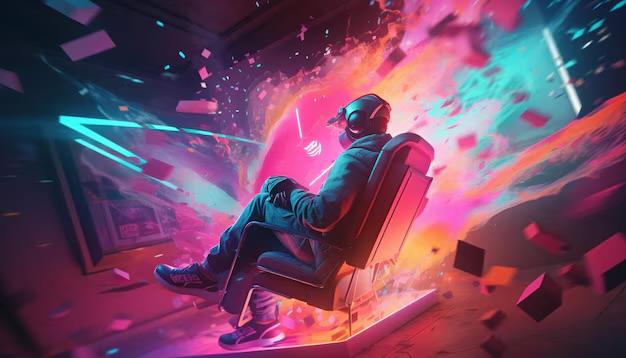The metaverse is a collective virtual shared space, creating a persistent, online universe where users can interact with each other and digital objects in a 3D environment.
It’s a convergence of virtual reality (VR), augmented reality (AR), and the internet, aiming to create an immersive experience where the physical and digital worlds blend seamlessly.

Core Components of the Metaverse
1.Virtual Reality (VR)
This technology creates entirely computer-generated environments, immersing users in a simulated world through headsets or specialized devices. Users can interact with this virtual world using controllers or body movements.
2. Augmented Reality (AR)
This technology overlays digital information onto the real world, enhancing the user’s perception of reality. AR applications range from mobile phone apps that provide real-time information about surroundings to industrial applications for maintenance and assembly
3. Blockchain
This underlying technology ensures security, transparency, and ownership of digital assets within the metaverse. It enables users to own virtual land, items, and even digital identities
4. Interoperability
This refers to the ability of different metaverse platforms to communicate and interact with each other. It allows users to seamlessly move between different virtual worlds and bring their digital assets with them.
The Promise of the Metaverse
The metaverse has the potential to transform various aspects of our live, here’s how:
1.Social Interaction
You can create virtual avatars, attend virtual events, concerts, and conferences, fostering new forms of social connections.
2.Gaming
The metaverse offers immersive gaming experiences, allowing players to explore vast virtual worlds,interact with other players, and even earn real-world value from in-game assets.
3.Education
Immersive learning environments can be created, offering students opportunities to explore historical events, conduct virtual experiments, and collaborate with peers from around the world.
4. Commerce
Virtual stores, digital goods, and virtual real estate will become part of the economy, creating new business opportunities and revenue streams.
5.Remote Work
Virtual offices and collaborative tools can enable remote teams to work together in a shared digital space, enhancing productivity and collaboration.
Challenges and Opportunities
Building a successful metaverse is a complex step with several challenge
1.Technological Limitations
Current VR and AR hardware still has limitations in terms of resolution, comfort, and processing power. Additionally, high-speed internet connectivity is essential for seamless experiences.
2. User Experience
Creating an intuitive and engaging metaverse experiences requires careful design and user testing.Balancing immersion with usability is important.
3. Standardization
Establishing common protocols and standards is essential for interoperability between different metaverse platforms. This will facilitate seamless user experiences and prevent fragmentation
4. Privacy and Security
Protecting user data, preventing cyberattacks, and addressing issues of identity theft are critical concerns. Robust security measures must be in place.
The Future of the Metaverse
The metaverse is still in its early stages, but its potential is undeniable. As technology advances and user adoption grows,we can expect fast development and expansion of this virtual world.
It is likely to become an integral part of our daily lives, joing the lines between the physical and digital realms.

















